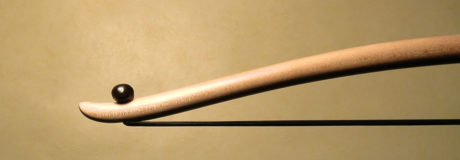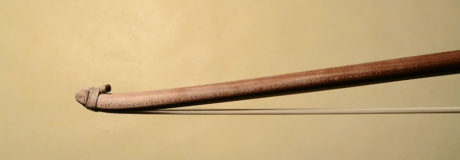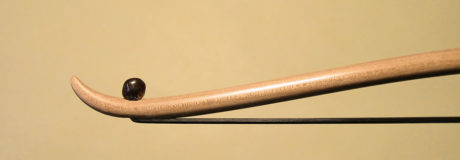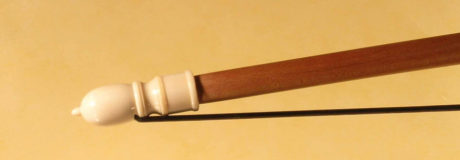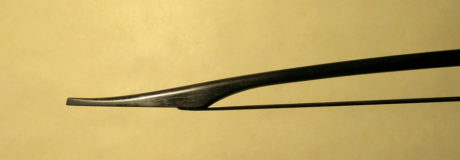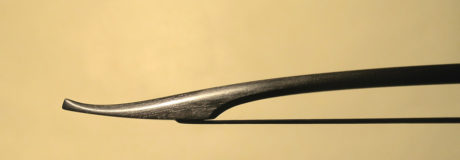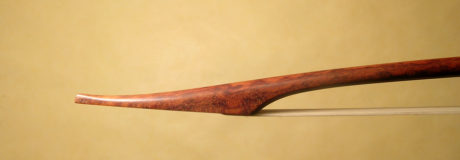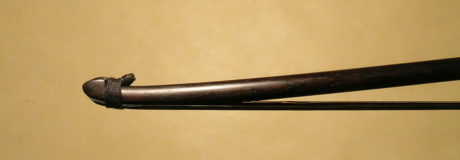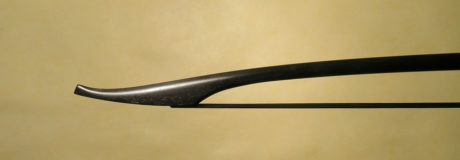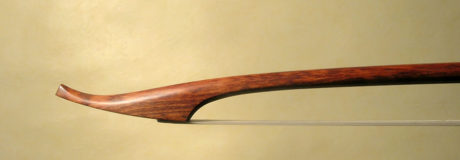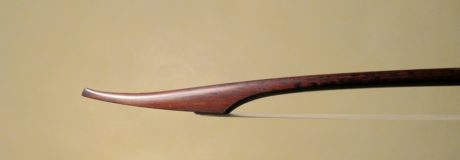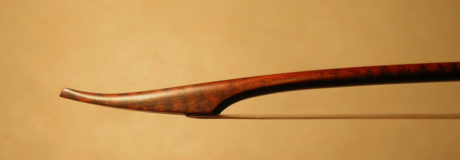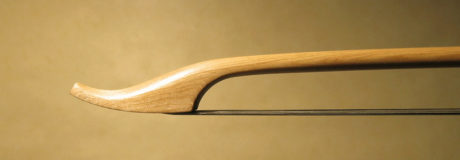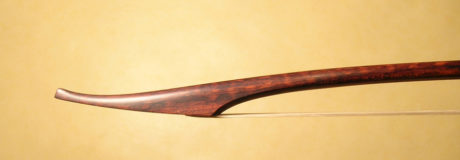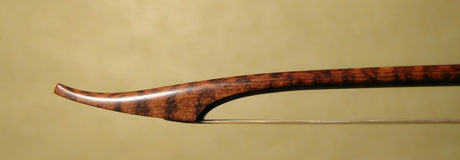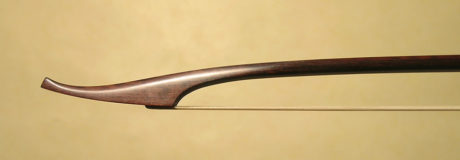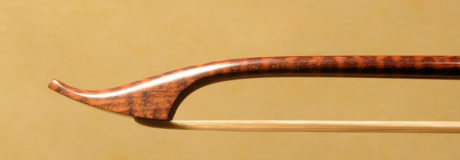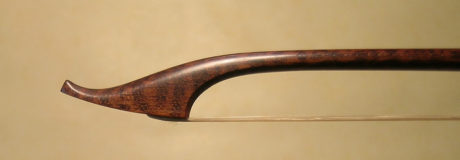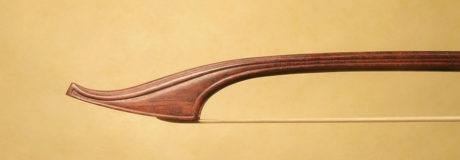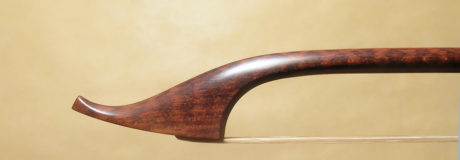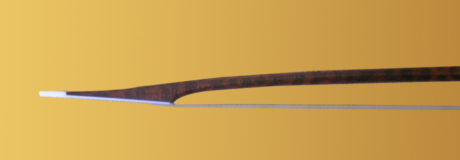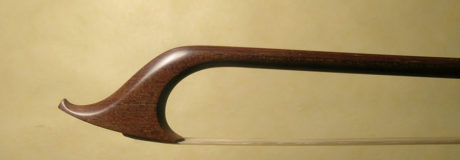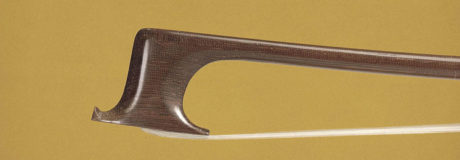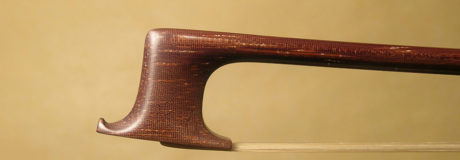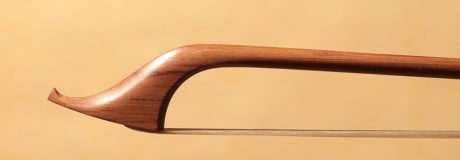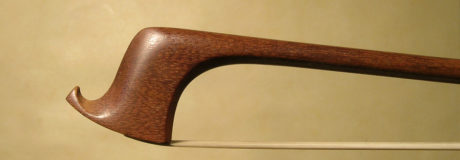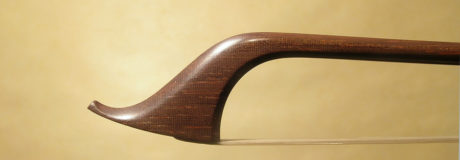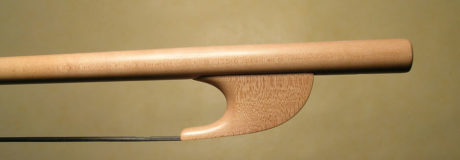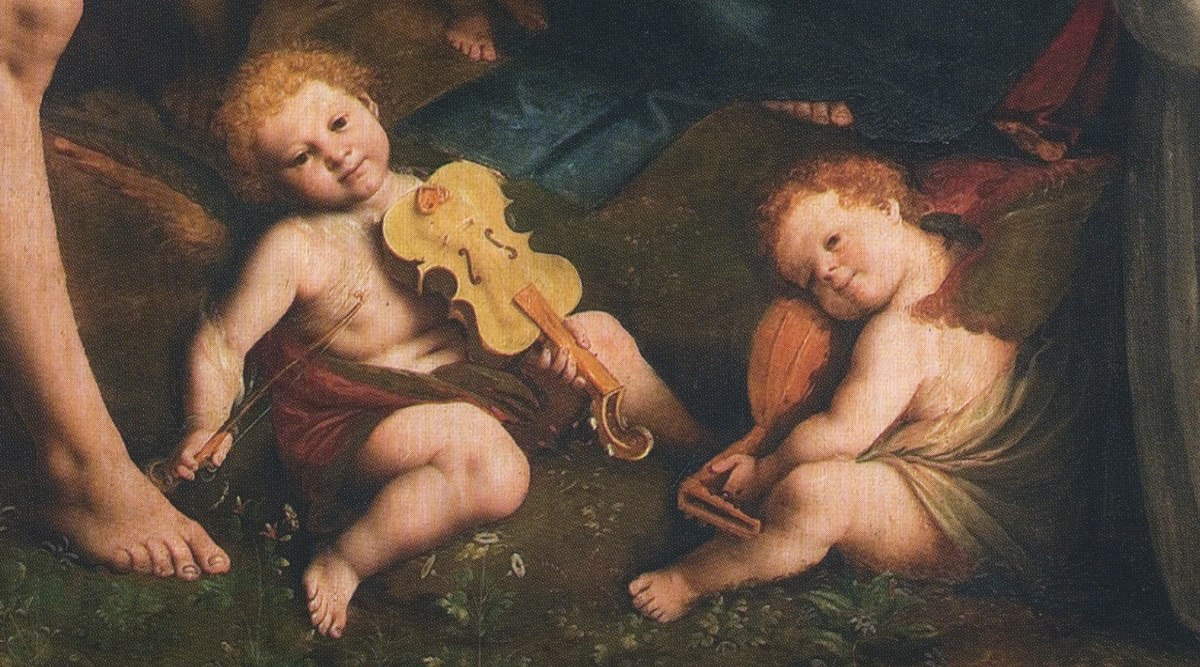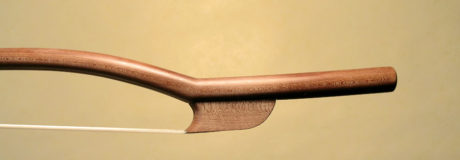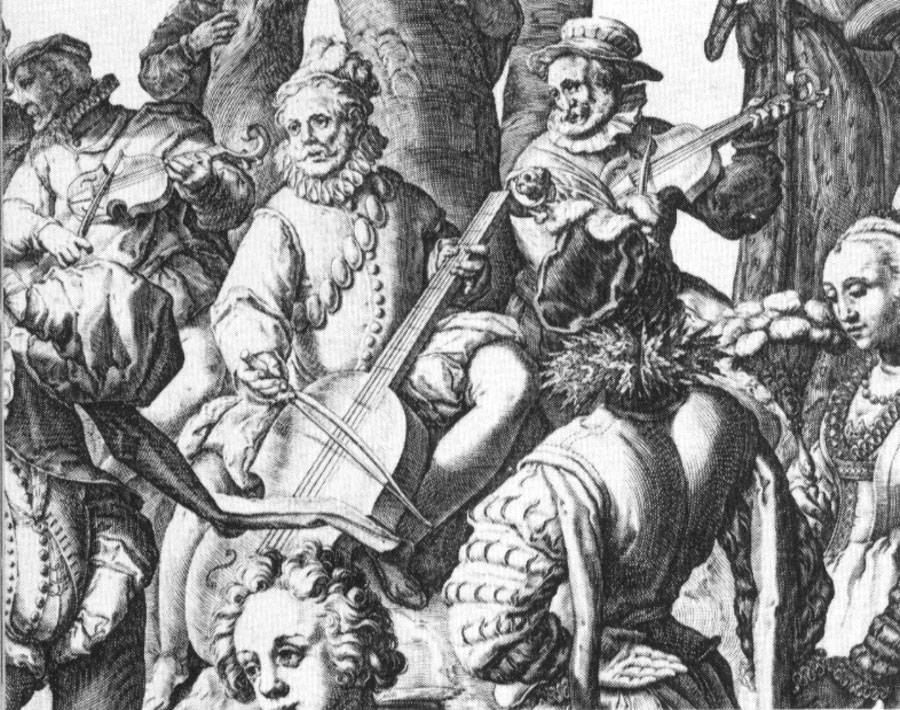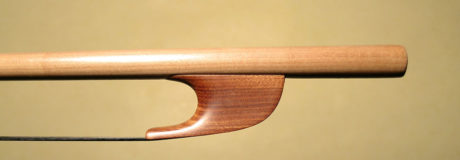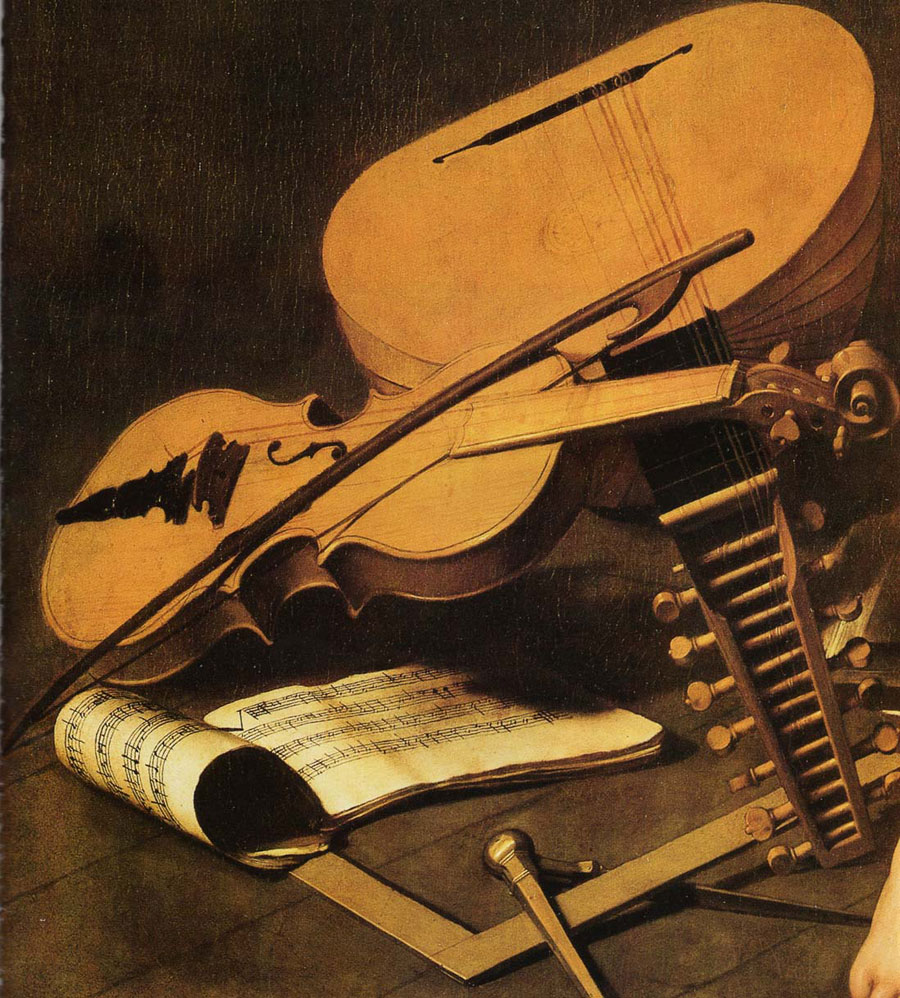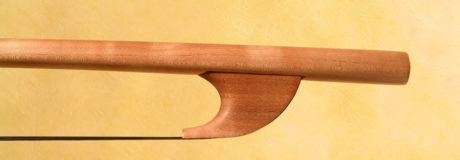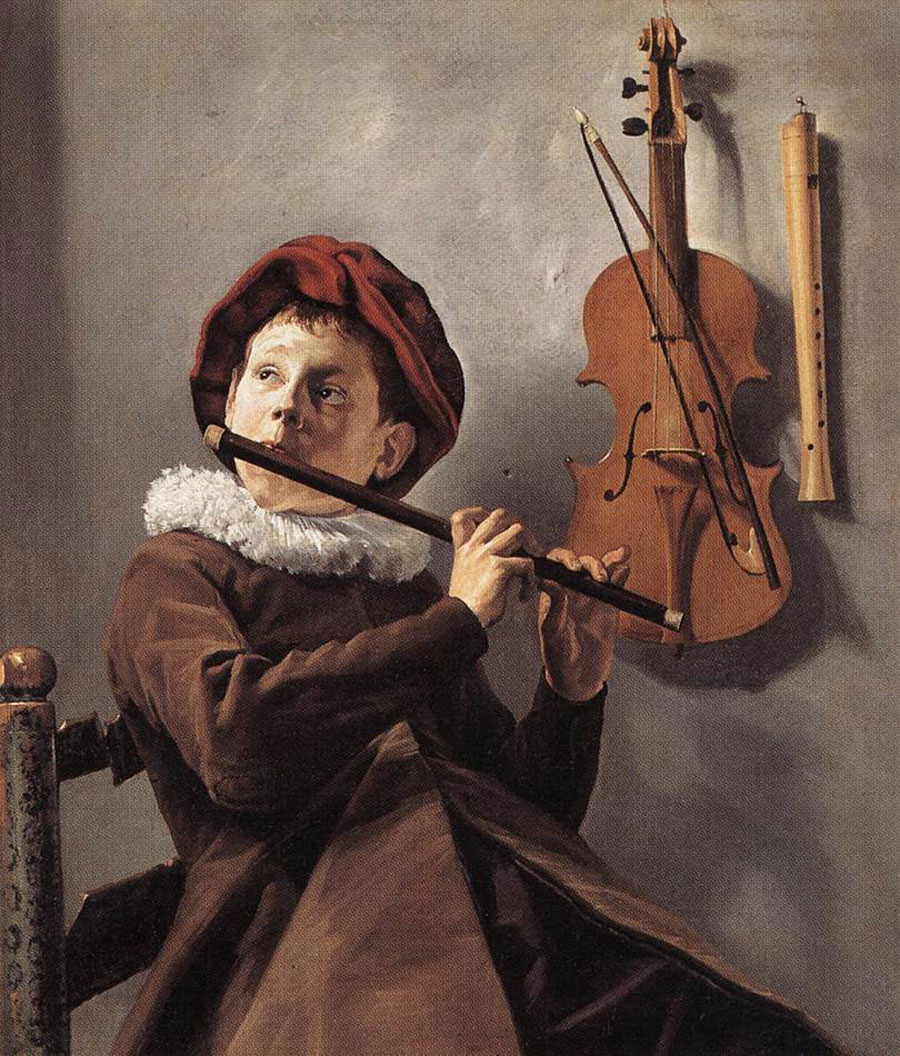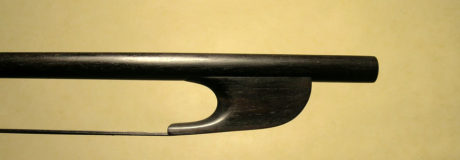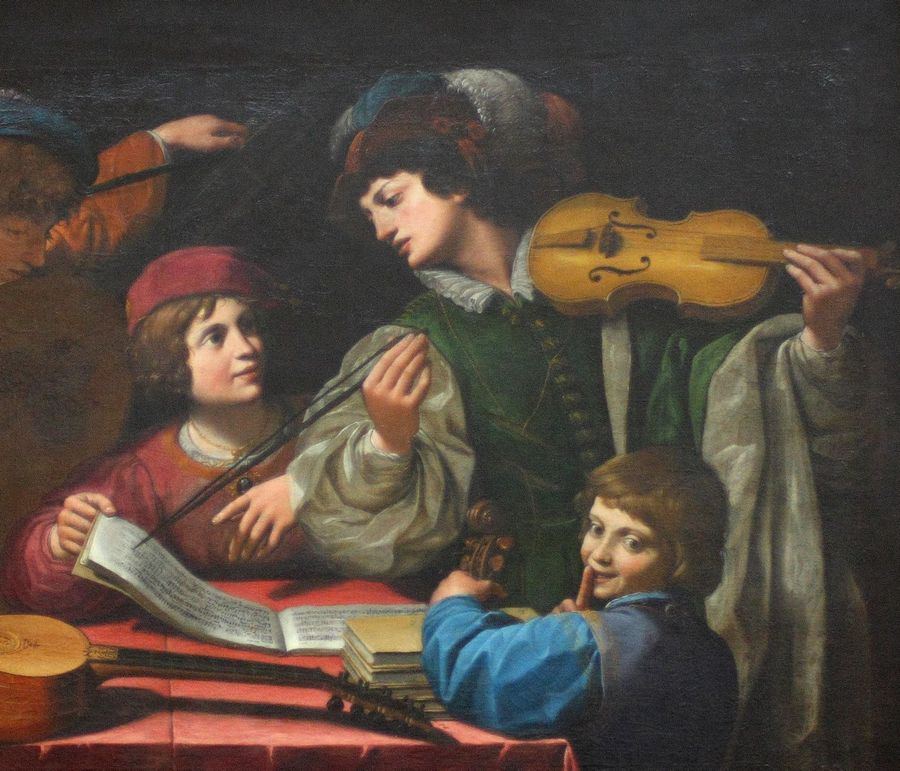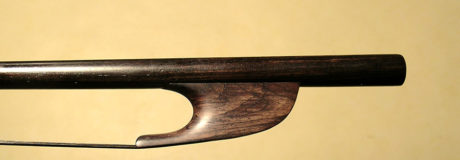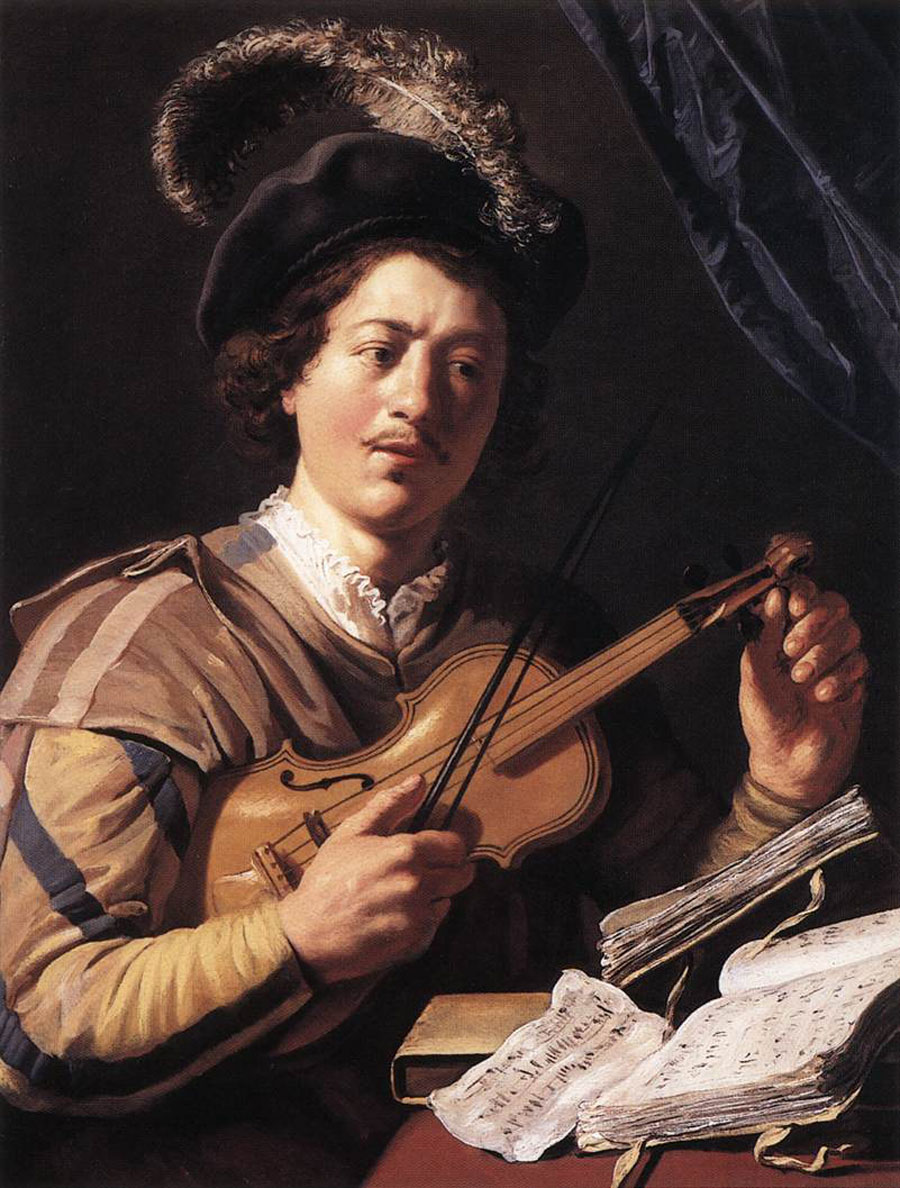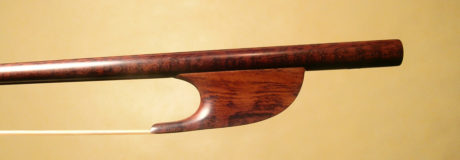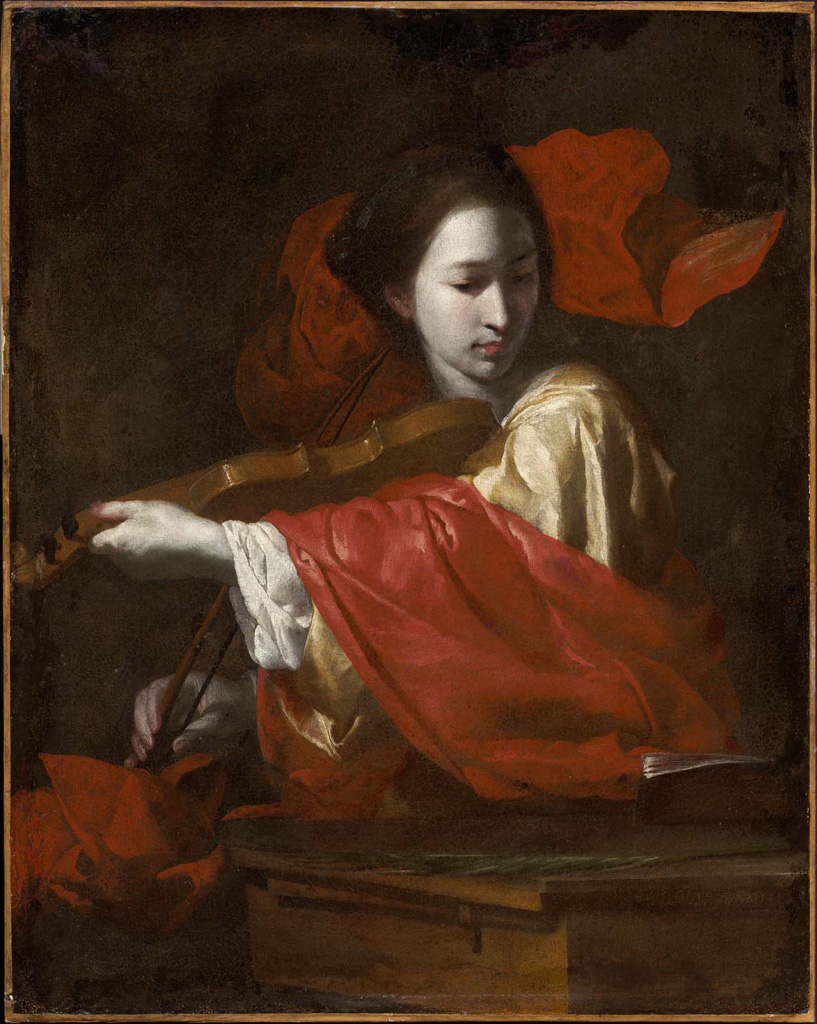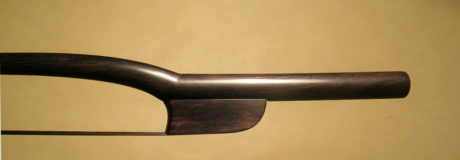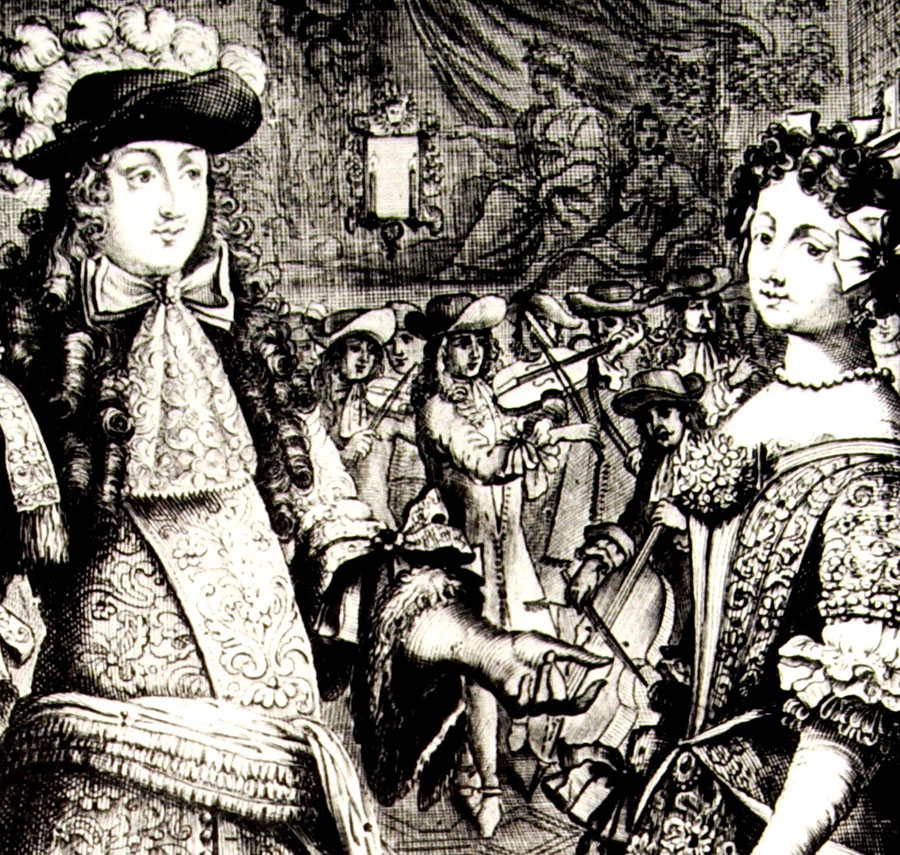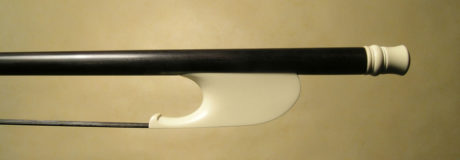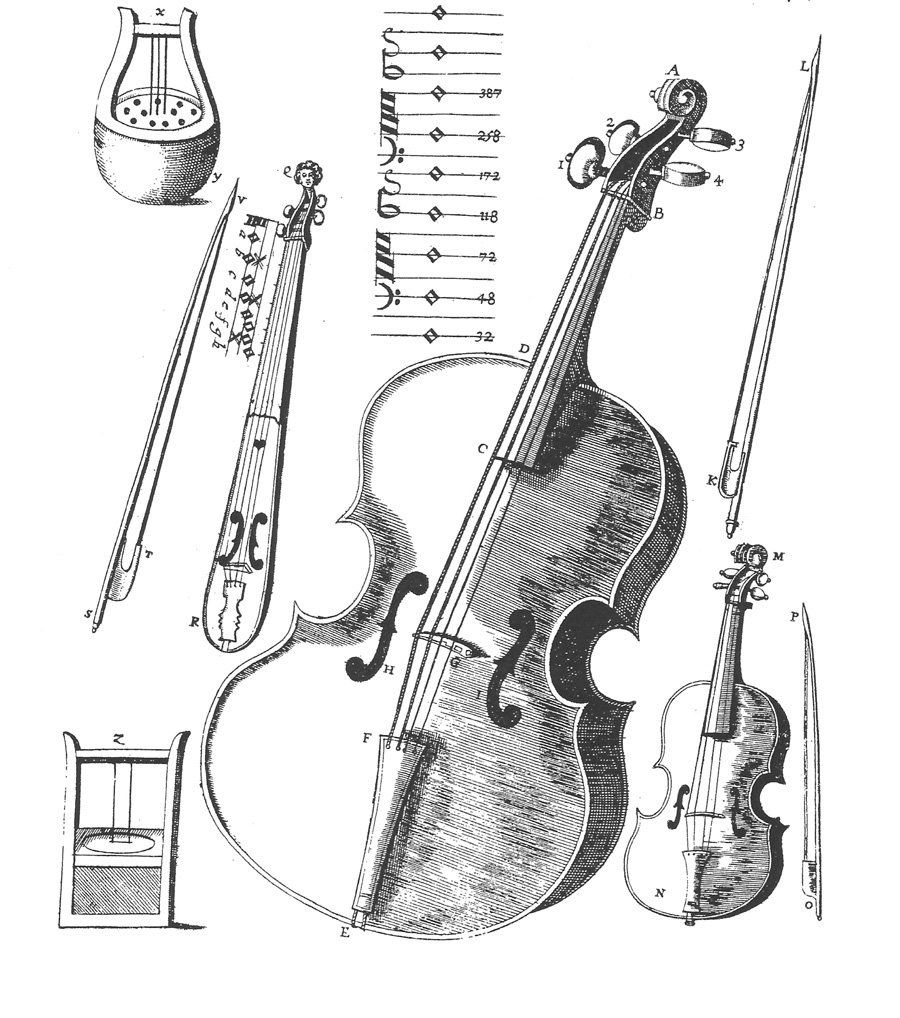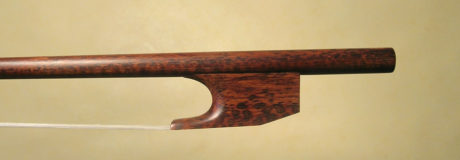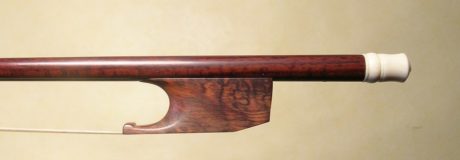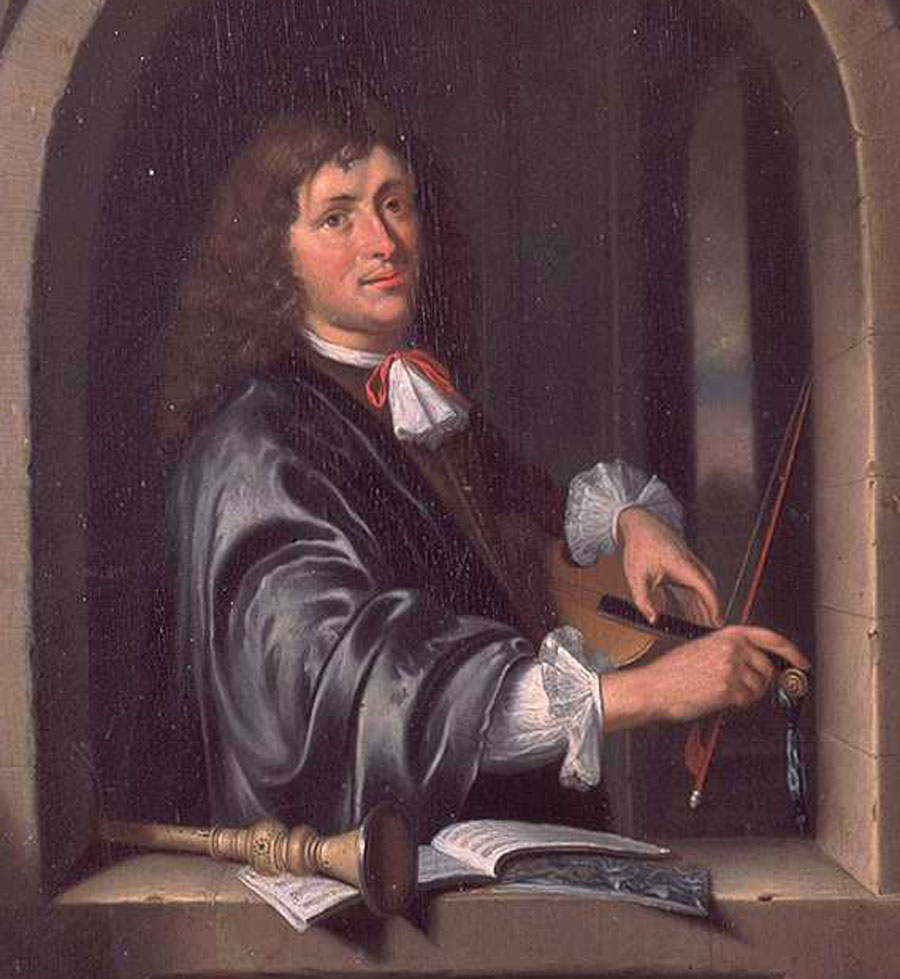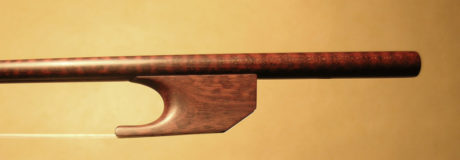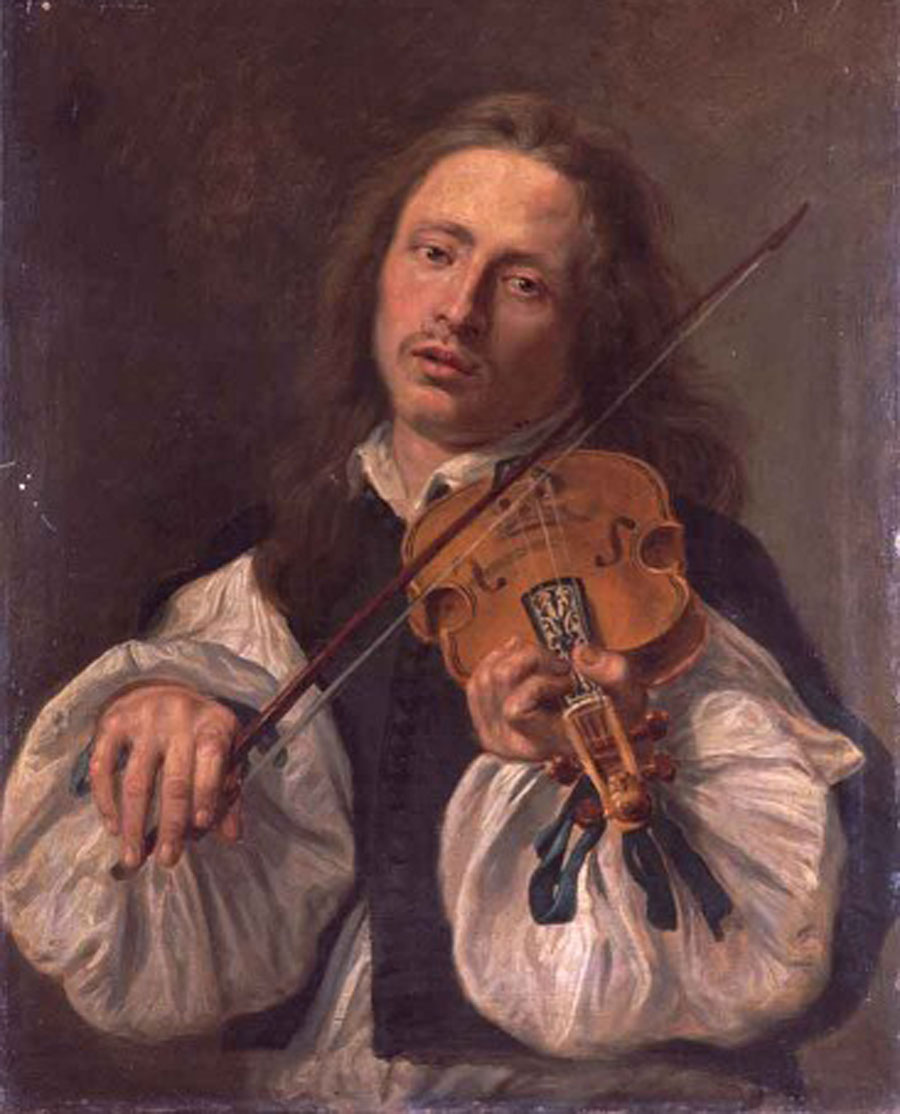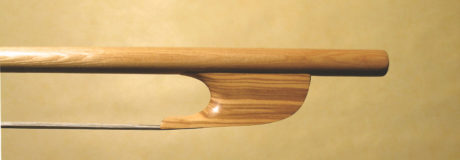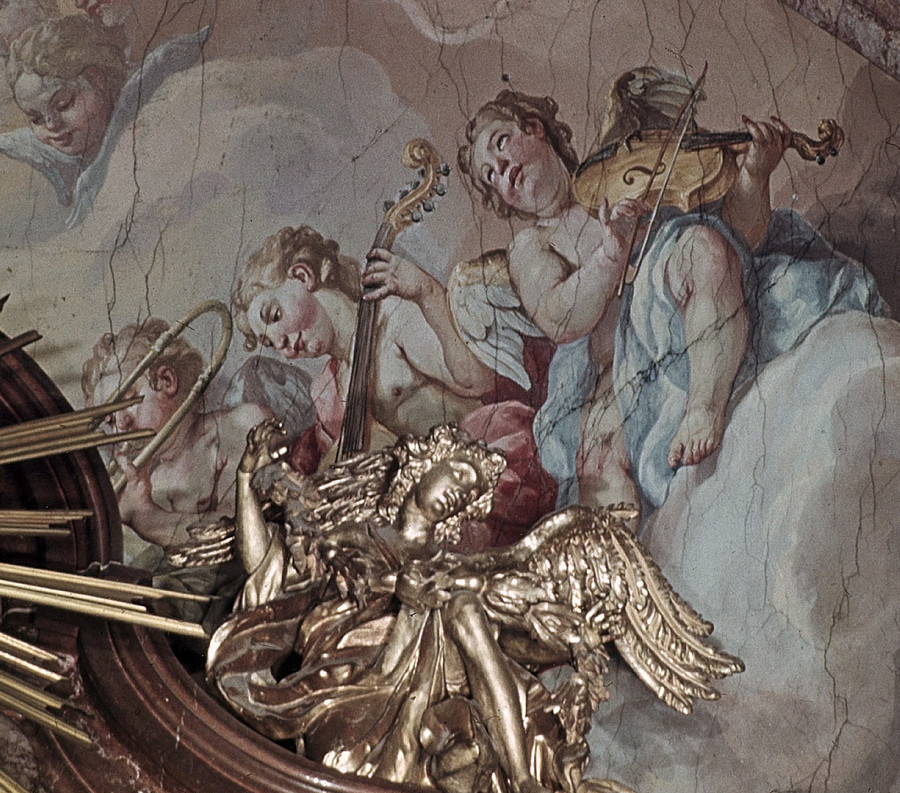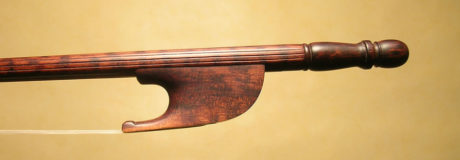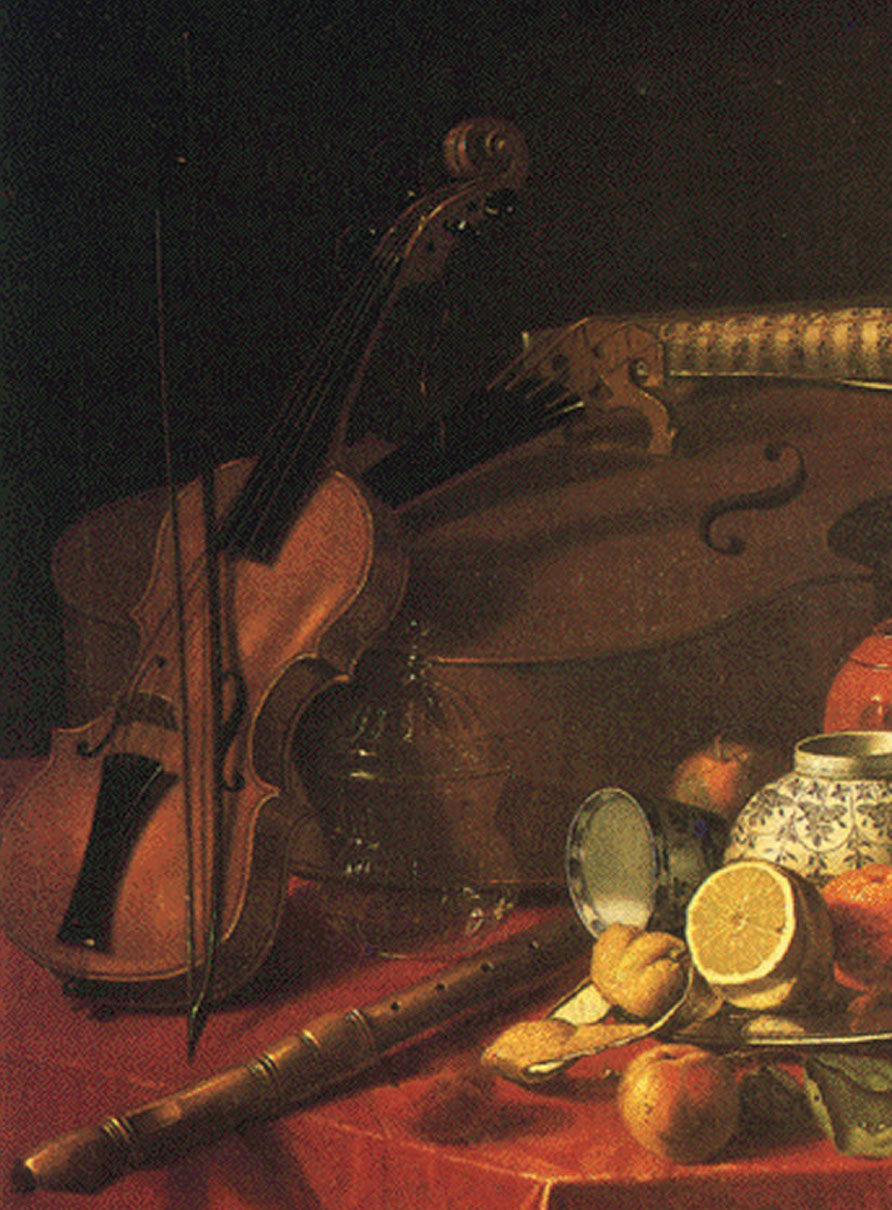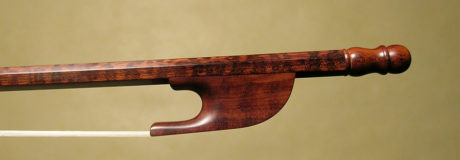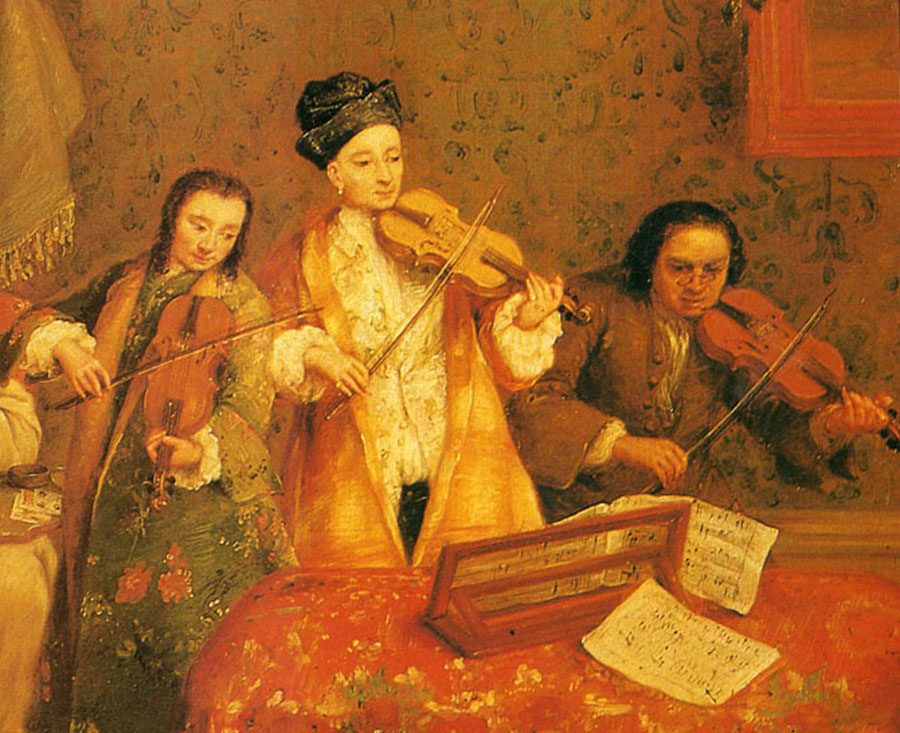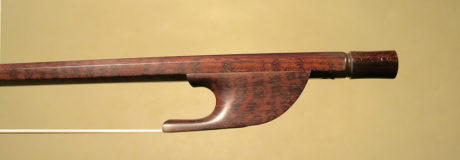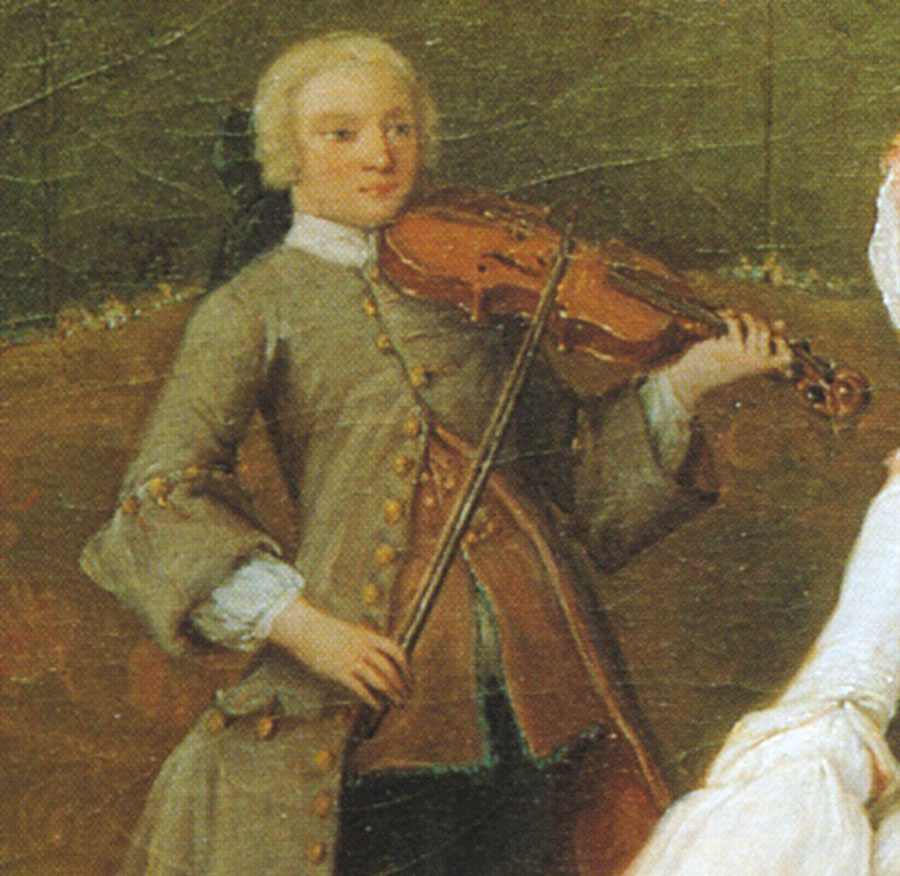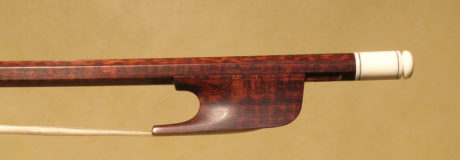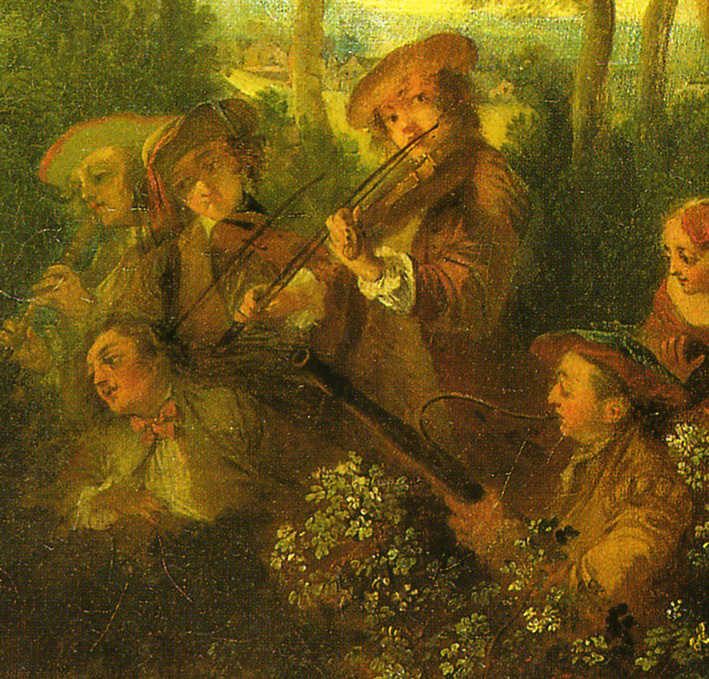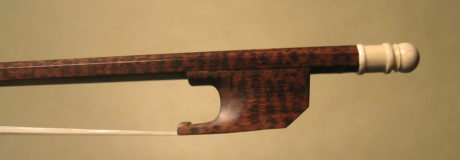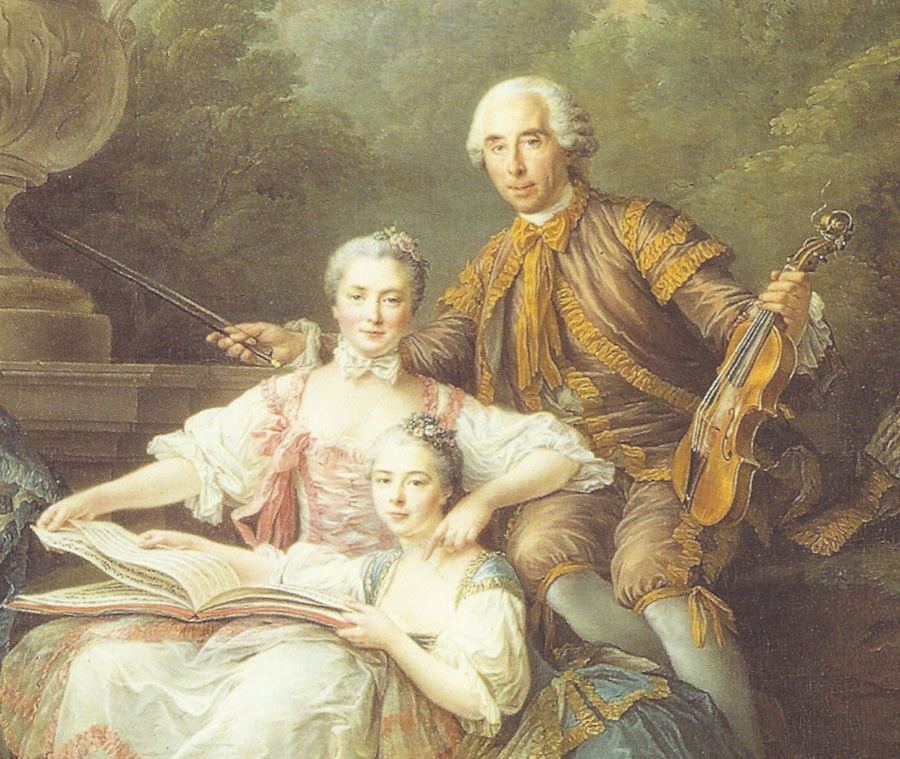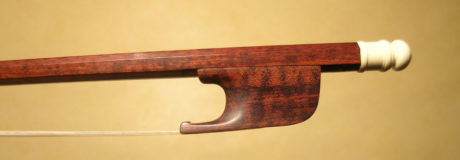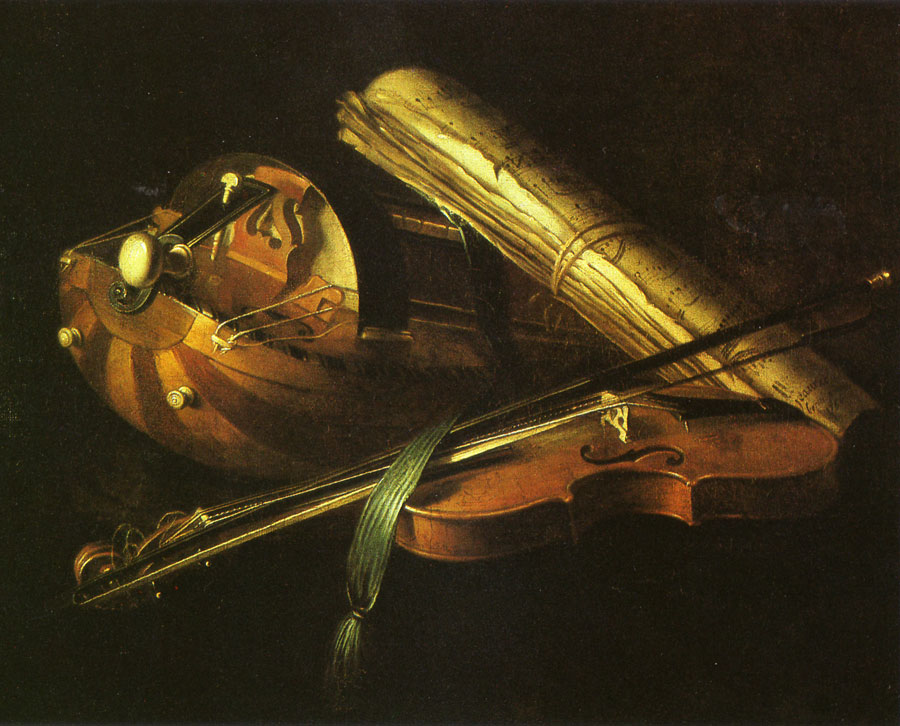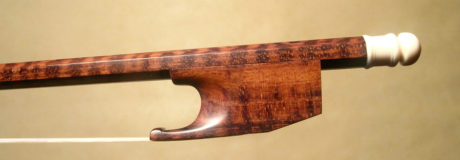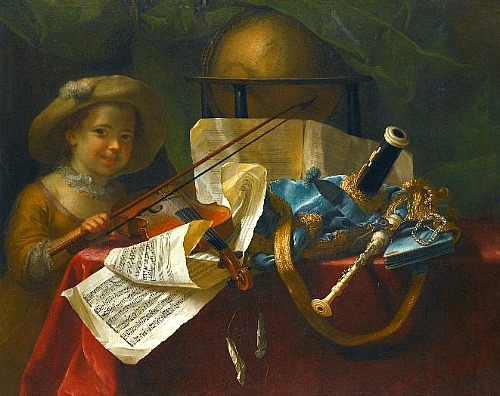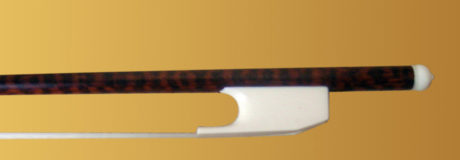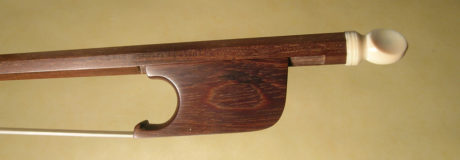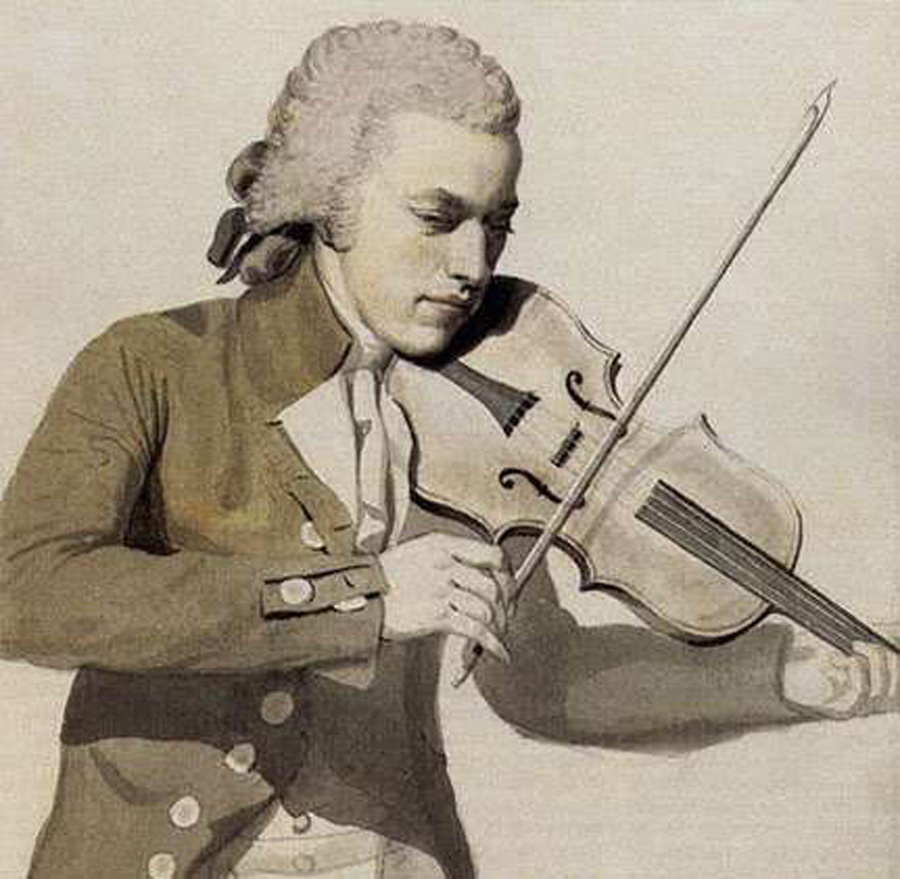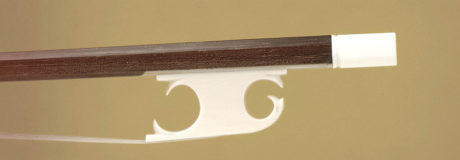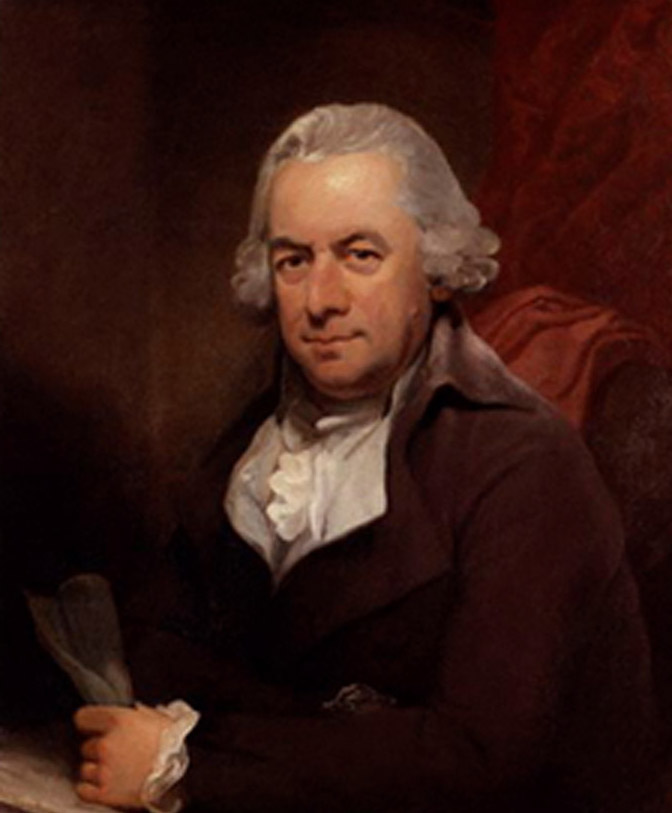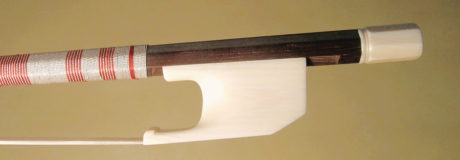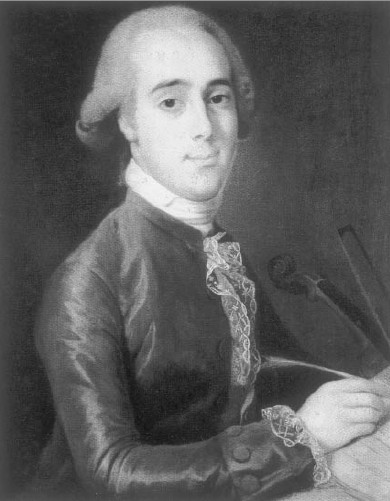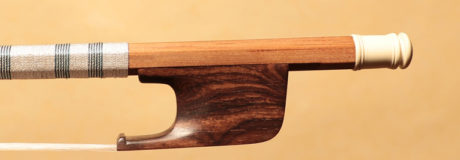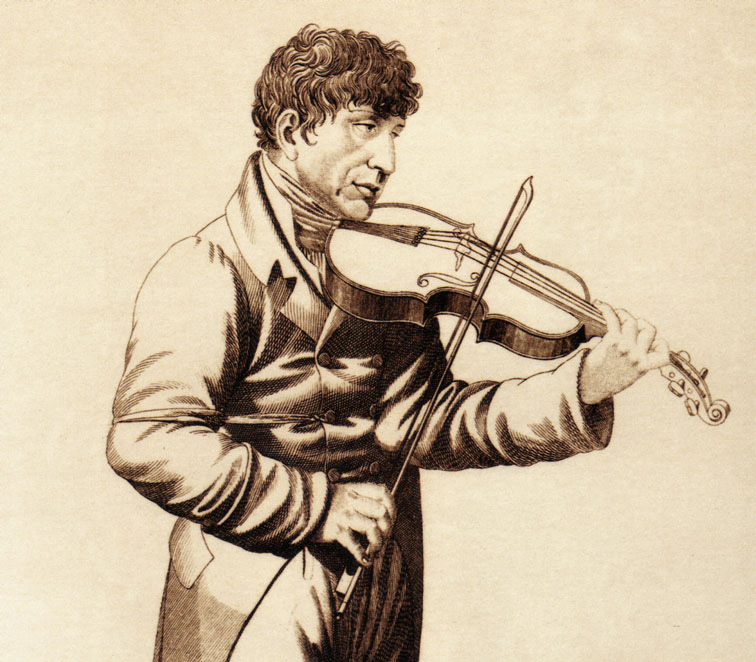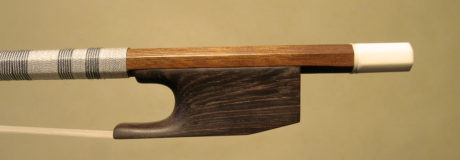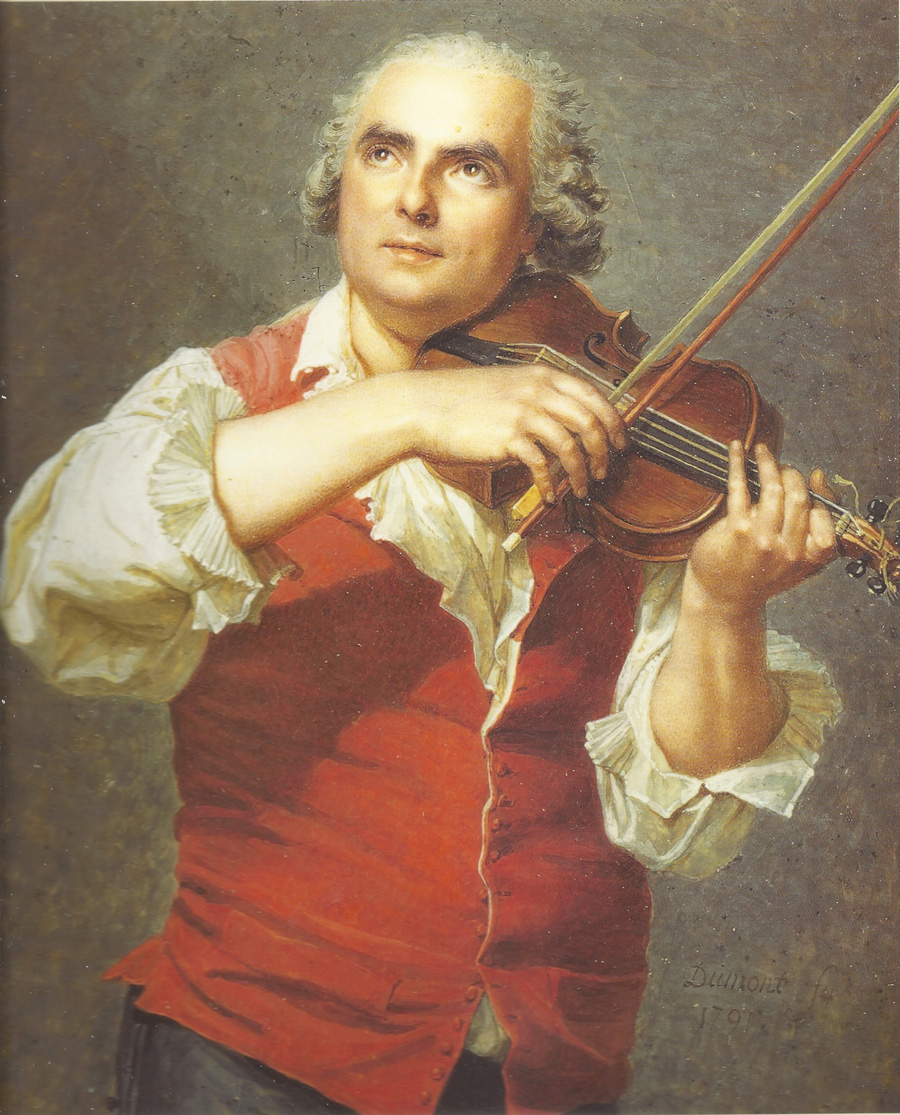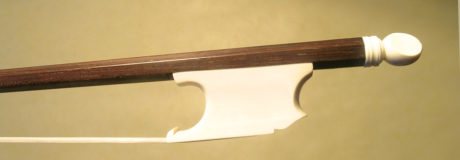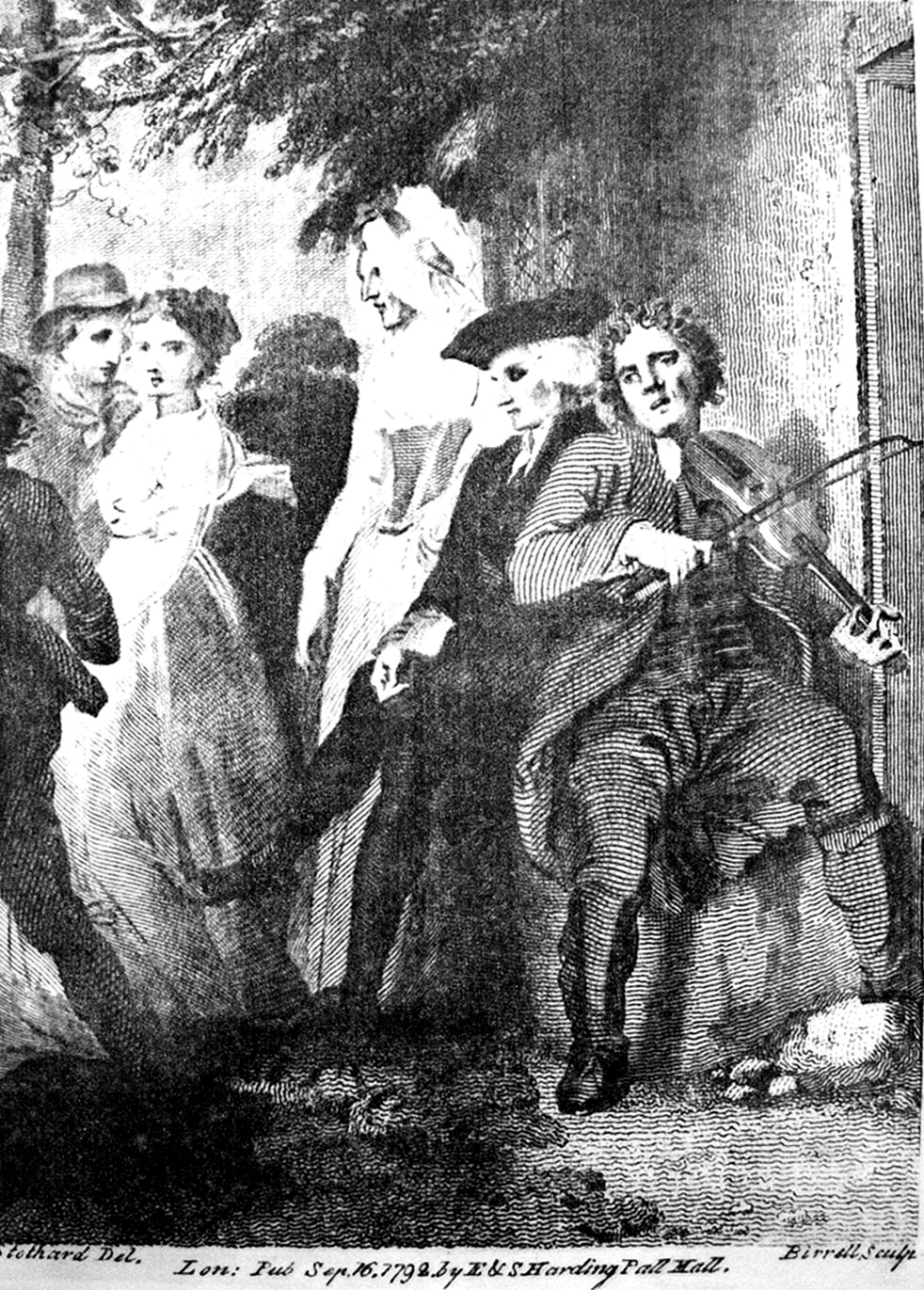Renaissance violin bow
Ref. Vnr1Renaissance violin sickle shaped bow
Ref. Vnr2Late 16th-early 17th violin bow
Ref. Vnr3Violin bow with bone cap
Ref. Vnr4Early 17th century bow
Ref. Vnb1Early 17th African blackwood bow
Ref. Vnb2Mid-17th violin bow
Ref. Vnb317th century French violin bow
Ref. Vnb417th century French violin bow
Ref. Vnb5Late 17th century French violin bow
Ref. Vnb6Late 17th century Italian bow
Ref. Vnb8Early 18th century German violin bow
Ref. Vnb9Early 18th century violin bow
Ref. Vnb10Student baroque violin bow
Ref. Vnb12Mid-18th century French violin bow
Ref. Vnb14Fluted violin bow
Ref. Vnb15Late baroque violin bow
Ref. Vnb1617th century pochette bow
Ref. Vnp1Hatchet head violin bow, ca. 1780
Ref. Vnc3
Renaissance violin bow
Ref. Vnr1This very short and strong bow enables clear and separate articulation, rhythmic precision and a direct, penetrating tone.Its sprightliness, due to its lightness and stiffness, favours the performance of ornamentations and fast, improvised passage-works. It is specially adapted to dance accompaniment
Stick made of service-tre wood (sorbus domestica), clip-in frog
Stick length:50 cm
Playable hair length:41 cm
Weight:37-42 g
Gaudensio Ferrari. Madonna of the Orange Trees, 1529-30
Vercelli, chiesa San Cristoforo
Renaissance violin sickle shaped bow
Ref. Vnr2This model is a direct descendant of the medieval fiddle bows. It is the most widespread one in the 16th century representations. Despite the big distance between hair and stick in the arched part of the bow, there is no wobbling sensation on the strings because the hand, resting on the shaft with the thumb under the frog, is close to the hair plane. Stick made of service-tree wood (sorbus domestica), clip-in frog.
Stick length:52,5 cm
Playable hair length:41 cm
Weight:43-46 g
Jacques de Ghein. The Return of the Prodigal Son, 1596
San Francisco, Fine Arts Museum
Late 16th-early 17th violin bow
Ref. Vnr3Towards the end of the 16th century, the bows seem to become thinner and longer. The tip is notraised yet. This model keeps a clear articulation, great rhythmic precision and a sensation of lightness at the tip.
Stick made of service-tre wood (sorbus domestica), clip-in frog
Stick length:59 cm
Playable hair length:47 cm
Weight:48-50 g
Caravaggio. Love as conqueror, 1602-03
Berlin, Staaliche Museen
Violin bow with bone cap
Ref. Vnr4The hair is inserted into the cap that is adjusted at the tip of the stick. This device, largely represented in the 16th and early 17th centuries, greatly facilitates the placement of the horsehair and the adjustment of its length. Moreover, it changes the balance of the stick : by giving more weight to the tip, it makes the bow more precise and powerful.This model is mainly used in the context of dance or entertainment.
Stick made of service-tree wood (sorbus domestica), clip-in frog, cap made of bone
Stick length:47,5 cm
Playable hair length:42 cm
Weight:44-48 g
Judith Leyster. The young flute player, 1635
Stockholm, Nationalmuseum
Early 17th century bow
Ref. Vnb1Following the small Renaissance bows, this model marks the start of the Baroque period. It differs from its predecessors by the presence of a head. This brings more modulation in the performance while the bow keeps the dynamics of a short bow. The wood used is African blackwood (dalbergia melanoxylon), often mistaken for ebony, although it is a rosewood.
The bow is supplied with three frogs of different heights to allow variations of hair tension.
Stick length:54 cm
Playable hair length:43 cm
Weight:41-44 g
Leonello Spada. The concert, 1615
Paris, museé du Louvre (inv 681)
Early 17th African blackwood bow
Ref. Vnb2The liveliness of a still short stick, combined with the flexibility of the African blackwood, allows precise and subtle bow strokes, whose range is further widened thanks to a greater head height. This very dense wood brings above all a full and round sound.
The bow is supplied with three frogs of different heights to allow variations of hair tension.
Stick length:60 cm
Playable hair length:47 cm
Weight:50-52 g
Jan Lievens. Violin player, 1625
Leiden, Stedelijk Museum De Lakenhal
Mid-17th violin bow
Ref. Vnb3Over the 17th century, the bow gets gradually longer and thinner, thanks to the use of dense woods such as snakewood. While remaining precise and fast, the bow acquires a greater variety of tones, a wider range of expressions and dynamics.
The bow is supplied with three frogs of different heights to allow variations of hair tension. Snakewood stick.
Stick length:66 cm
Playable hair length:51 cm
Weight:46-49 g
Bernardo Cavallino. S. Cecila, ca.1645
Boston, Museum of Fine Arts
17th century French violin bow
Ref. Vnb4This type of bow is quite often the most pictured one in the hands of the musicians of La Chambre du Roy until the end of the 17th century. Despite its archaic appearance, it is recognizable in many engravings where we see that the hand laid on the handle is low, which confirms the idea that the stick comes down to the level of the hair (see on this subject my article published in L’orchestre à cordes sous Louis XIV).
Stick made of African blackwood (dalbergia melanoxylon)
Stick length:52 cm
Playable hair length:40 cm
Weight:49-52 g
Pierre Landry. Bal à la françoise, 1682
Versailles, Bibliothèque municipale
17th century French violin bow
Ref. Vnb5Inspired both by the plate of Orcheography that Mersenne devotes to the violin family (1636) and by the musical instruments trophies in the music gallery of the Royal Chapel of Versailles (1708-09), this bow testifies that the model has barely varied under the reign of Louis XIV, as well in the shape as in the length (see on this subject the article edited in L’orchestre à cordes sous Louis XIV).
Stick made of African blackwood, frog made of substitute for real ivory. The bow is supplied with three frogs of different heights to allow variations of hair tension.
Stick length:59,5 cm
Playable hair length:47 cm
Weight:50-52 g
Marin Mersenne. L’harmonie universelle
Livre quatriesme des instrumens à chordes, 1636
Late 17th century French violin bow
Ref. Vnb6Despite the common characteristics with the Italian bows of the same period, such as the general shape and the height of the head, this bow remains very short, as it used to be in France at the end of the XVIIth century. The small size of these bows is inseparable from the low holding of the violin (see on this subject my article published in L’orchestre à cordes sous Louis XIV, p 114)
Stick made of snakewood. The bow is supplied with three frogs of different heights to allow variations of hair tension.
Stick length:59 cm
Playable hair length:47 cm
Weight:47-50 g
Robert Feuillet. Still life with a violin, 1690
Strasbourg, Musée des Beaux-Arts
Second half of the 17th century violin bow
Ref. Vnb7This bow is built after an anonymous bow preserved in the Museum of Musical Instruments in Brussels. The original has been transformed and fitted with a screw-adjustable frog, but it still shows the traces of the previous location of the clip-frog. This reconstruction restores the original tension system which guarantees great liveliness if the frog is tightly held by the hair at the rear. The button, besides its decorative aspect, has a balance function.
Stick made of snakewood. The bow is supplied with three frogs of different heights to allow variations of hair tension.
Stick length:68,5 cm
Playable hair length:53,5 cm
Weight:48-50 g
Pieter Cornelisz van Slingelandt. Violin player, 1670
Sibiu, Brukenthal Museum
Late 17th century Italian bow
Ref. Vnb8Designed from several iconographic sources, this model keeps all the liveliness of the clip-in frog bows despite the hair lengthening. The extra-length of stick beyond the frog provides a good balance.
Stick made of snakewood. The bow is supplied with three frogs of different heights to allow variations of hair tension.
Stick length:70 cm
Playable hair length:55 cm
Weight:environ 50 g
Gonzales Coques. Hearing, ca.1660
Sibiu, Brukenthal museum
Early 18th century German violin bow
Ref. Vnb9This bow is a copy of a stick found under the organ floor of the Saint Martin church in Klosterneuburg in Austria. The history of the building allows its datation between 1683 and 1725. The stick is made of larch, unusually quarter sawn. The bow is very light and very lively and allows great subtlety of dynamics.
The bow is supplied with three frogs of different heights to allow variations of hair tension.
Stick length:67 cm
Playable hair length:54 cm
Weight:36-38 g
Johann Michael Rottmayr, Musical angels, 1729-30
Klosterneuburg (Austria), Collegiate Church of the Nativity
Early 18th century violin bow
Ref. Vnb10Based on an Italian model, originally with a clip-in frog but fitted here with a screw-and-eyelet system, this bow has kept the low head and the rather convex shape of the late 17th century bows.
Snakewood stick.
Stick length:69,5 cm
Playable hair length:58,5 cm
Weight:49-51 g
Cristoforo Munari. Still life, 1706-15
Florence, Uffizi Gallery
Violin bow from the first third oh the 18th century
Ref. Vnb11With a higher head than the Vnb9 model, it is a quite versatile bow.
Snakewood stick and frog.
Stick length:69,5 cm
Playable hair length:59 cm
Weight:48-51 g
Pietro Longhi. The concert, 1741
Venice, Galleria dell’Accademia
Student baroque violin bow
Ref. Vnb12Built on the same model as the Vnb11, this bow owes its lower cost to greater aesthetic sobriety and a simpler three-faceted frog fitting.
Snakewood stick and frog.
Stick length:69,5 cm
Playable hair length:59 cm
Weight:48-50 g
Pietro Longhi. The Dancing lesson, ca. 1741
Venice, Galleria dell’Accademia
Violin French bow from the second third of the 18th century
Ref. Vnb13Built in copy of an anonymous French bow preserved at the Museum of Music in Paris, this model has two distinguished features : a very low frog with a quite high head.
Snakewood stick and frog
Stick length:68 cm
Playable hair length:58 cm
Weight:47-50 g
Nicolas Lancret. La Camargo dancing, 1730-31
Nantes, Musée d’Arts
Mid-18th century French violin bow
Ref. Vnb14Inspired by several models by Nicolas Pierre Tourte, this bow offers fairly the same playing height at the tip and at the heel, which leads to greater equality of the up-bow and the down-bow than on previous models.
Snakewood stick.
Stick length:68,5 cm
Playable hair length:59,5 cm
Weight:49-51 g
François-Hubert Drouais. Louis du Bouchet, marquis de Sourches and his family, 1756
Versailles, Château de Versailles
Fluted violin bow
Ref. Vnb15This bow is made after a model by Nicolas Pierre Tourte. Fluting lightens the bow at the head without weakening the stick which keeps its edges (on this subject see my article Une histoire de l’archet de violon de la Renaissance au tournant du XIXe siècle)
Snakewood stick.
Stick length:68,5 cm
Playable hair length:59,5 cm
Weight:49-52 g
Nicolas Jeaurat de Bertry. Musical instruments, 1756
Paris, Musée Carnavalet
Late baroque violin bow
Ref. Vnb16This bow owes its flexibility and its singing character undoubtedly to its quite high head. Balance is obtained with a slightly massive frog, typical of the time, to offset the weight of the head.
Snakewood stick.
Stick length:69 cm
Playable hair length:59,2 cm
Weight:50-52 g
Nicolas Jeaurat de Bertry. Objects of curiosity arranged on a table which surmounts a world map and musical instruments, 1775
17th century pochette bow
Ref. Vnp1Instrument of the dancing master, the pochette has been represented in several vanities by Simon Renard de Saint-André, always accompanied by the same bow from which this model is inspired.
Stick length:47,5 cm
Playable hair length:36 cm
Weight:environ 30 g
Simon Renard de Saint-André (1613-1677). Vanity
Marseille, Musée des Beaux-Arts
Classical violin bow after Edward Dodd
Ref. Vnc1Edward Dodd's original is kept at the Kunsthistorisches Museum in Vienna. It is a rather early model which represents a real transition between baroque and classical bow. His head is light, which gives him a good balance. Its camber is not very pronounced.
Stick made of ferreol (swartzia panacoco) or of boco (boco prouacensis)
Stick length:68,8 cm
Playable hair length:60,2 cm
Weight:52-55 g
Edward Francis Burney. Portrait of Charles Rousseau Burney, 1775-80
Londres, National Portrait Gallery
Cramer violin bow after Joseph Meauchand, ca. 1775
Ref. Vnc2Iconic model of the last quarter of the 18th century, the Cramer model is characterized by a hatchet-shaped head and a finely cut frog riding on a flat ivory plate. Because of this type of attachment, the musician's hand was placed well ahead of the frog, which is confirmed by the length of the silk winding on old bows. It is also a way to offset the weight of the head.
Ferreol (swartzia panacoco) stick, mammoth ivory frog.
Stick length:69 cm
Playable hair length:61 cm
Weight:52-54 g
Thomas Hardy. Portrait of Wilhelm Cramer, 1794
Londres, National Portrait Gallery
Hatchet head violin bow, ca. 1780
Ref. Vnc3The original bow that served as a model for this bow is the fruit of the collaboration between Léonard and François-Xavier Tourte. The weight of the ivory frog allows this bow to be perfectly balanced. The use of ferreol, also called partridge wood at the time, is evidenced by invoices from François-Xavier and some preserved bows made by the two brothers.
Baguette en ferréol (swarzia panacoco), hausse en ivoire de mammouth ou en bois très dense
Stick length:69,5 cm
Playable hair length:60,5 cm
Weight:54-56 g
Portrait of Pietro Nardini, v. 1770
Milan, Museo Teatrale alla Scala
Classical violin bow after Leonard and François-Xavier Tourte, ca. 1785-90
Ref. Vnc4The lightness of the very slender head as well as the counterweight length behind the frog give this stick a comfortable balance. The playable hair length enables an extended repertoire.
Stick made of ferreol (swartzia panacoco) or licania alba, called long-leafed caraipe during the 18th century.
Stick length:72 cm
Playable hair length:63,3 cm
Weight:53-55 g
Illustration from Bartolomeo Campagnoli's New method for the violin, 1824
Paris, Bibliothèque Nationale de France
Classical violin bow after Leonard Tourte, ca. 1790
Ref. Vnc5This model is the closest to romantic bow, regarding its head, its robust stick and its pronounced camber. It allows a rather late repertoire.
Stick made of ferreol (swartzia panacoco) or of greenheart (chlorocardium rodiei)
Stick length:71,2 cm
Playable hair length:61,6 cm
Weight:54-56 g
François Dumont l’AÎné, Portrait of Marie Alexandre Guénin, 1791
Paris, Musée du Louvre
Classical violon bow after John Dodd, ca. 1790
Ref. Vnc6The original by John Dodd who served as a model for this bow is exceptionally elegant, thanks to the delicacy of its head and the perfect line of its stick. The aesthetic of the frog and the button is typical of the author.
Ferreol (swartzia panacoco) stick, mammoth ivory frog.
Stick length:71 cm
Playable hair length:61,5 cm
Weight:51-53 g
Londres, British Museum. Engraved in 1792 by O. Birrell for "A sentimental Journey" by Sterne
Thomas Stodhard, The dance in Amiens

